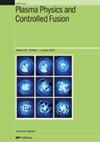在 MAIZE LTD 发生器的氘化混合 x-pinch 中使用 MeV 核聚变驱动质子和加速氘核进行自驱动离子偏转测量
IF 2.3
2区 物理与天体物理
Q2 PHYSICS, FLUIDS & PLASMAS
引用次数: 0
摘要
我们报告了一个中等规模大学z-pinch实验的点投射离子偏转测量结果。密歇根大学的 1 MA 8 kJ LTD 发生器(称为 MAIZE)驱动着一个带有氘化聚乙烯纤维负载的混合 x-pinch (HXP),以产生用于背光源的点状 MeV 离子源。在这些实验中,2.7 MeV 质子是通过 DD 束-靶聚变反应产生的。由于束靶聚变反应的运动学原理,质子能量从更标准的 3.02 兆电子伏质子能量向下偏移,而 3.02 兆电子伏质子能量是从 DD 反应的质量中心静止帧释放出来的。除了 2.7 兆电子伏的质子外,放置在距离 x-pinch 90 毫米径向距离的离子诊断仪还探测到了 3 兆电子伏加速氘核的强各向异性束。通过对偏转氢离子轨迹产生的实验数据进行数值重建,评估了真空负载区的总电流。数字离子跟踪模拟显示,加速的氘核束在离开离子源区域时与夹钳电流方向成很大的角度。本文章由计算机程序翻译,如有差异,请以英文原文为准。
Self-driven ion deflectometry measurements using MeV fusion-driven protons and accelerated deuterons in the deuterated hybrid x-pinch on the MAIZE LTD generator
We report on the results of point-projection ion deflectometry measurements from a mid-size university z-pinch experiment. A 1 MA 8 kJ LTD generator at the University of Michigan (called MAIZE) drove a hybrid x-pinch (HXP) with a deuterated polyethylene fiber load to produce a point-like source of MeV ions for backlighting. In these experiments, 2.7 MeV protons were generated by DD beam-target fusion reactions. Due to the kinematics of beam-target fusion, the proton energies were down-shifted from the more standard 3.02 MeV proton energy that is released from the center-of-mass rest frame of a DD reaction. In addition to the 2.7 MeV protons, strongly anisotropic beams of 3 MeV accelerated deuterons were detected by ion diagnostics placed at a radial distance of 90 mm from the x-pinch. Numerical reconstruction of experimental data generated by deflected hydrogen ion trajectories evaluated the total current in the vacuum load region. Numerical ion-tracking simulations show that accelerated deuteron beams exited the ion source region at large angles with respect to the pinch current direction.
求助全文
通过发布文献求助,成功后即可免费获取论文全文。
去求助
来源期刊

Plasma Physics and Controlled Fusion
物理-物理:核物理
CiteScore
4.50
自引率
13.60%
发文量
224
审稿时长
4.5 months
期刊介绍:
Plasma Physics and Controlled Fusion covers all aspects of the physics of hot, highly ionised plasmas. This includes results of current experimental and theoretical research on all aspects of the physics of high-temperature plasmas and of controlled nuclear fusion, including the basic phenomena in highly-ionised gases in the laboratory, in the ionosphere and in space, in magnetic-confinement and inertial-confinement fusion as well as related diagnostic methods.
Papers with a technological emphasis, for example in such topics as plasma control, fusion technology and diagnostics, are welcomed when the plasma physics is an integral part of the paper or when the technology is unique to plasma applications or new to the field of plasma physics. Papers on dusty plasma physics are welcome when there is a clear relevance to fusion.
 求助内容:
求助内容: 应助结果提醒方式:
应助结果提醒方式:


